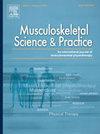Development of a clinical decision-support tool for management of adolescent knee pain (The MAP-Knee tool)
IF 2.2
3区 医学
Q1 REHABILITATION
引用次数: 0
Abstract
Background
Adolescent knee pain was historically viewed as a self-limiting condition. Still, it may severely impact health-related quality of life and physical activity, and almost half of adolescents may continue to experience pain into adulthood. Currently, no tool is available to support the consultation and shared decision-making process when an adolescent suffering from non-traumatic knee pain presents at clinical practice. By supporting shared decision-making and tailoring management strategies, such a tool could optimize treatment delivery and improve the prognosis of this common condition.
Objectives
This study aimed to develop a clinical decision-support tool (The MAP-Knee Tool) to improve the management of adolescents with non-traumatic knee pain.
Design
Development study with end-user testing.
Method
This multi-step study consisted of five steps ((1-4) initial development and (5) end-user testing with adolescents with or without non-traumatic knee pain and medical doctors). It ended with the first version of the MAP-Knee Tool for the six most common non-traumatic knee pain conditions. The tool includes four components: 1) tool for diagnosing, 2) credible explanations of the diagnoses based on two systematic literature searches and an Argumentative Delphi process with international experts, 3) prognostic factors based on an individual participant data meta-analysis, and 4) option grid including an unbiased presentation of management options based on the available evidence.
Results
We included seven children/adolescents (8–15 years old) and seven medical doctors for the end-user testing. All four components were revised accordingly, and the text was condensed as the initial draft was too comprehensive.
Conclusions
We developed a clinical decision-support tool for clinicians and adolescents with non-traumatic knee pain based on a multi-step process, including end-user testing to support the consultation in clinical practice.
求助全文
约1分钟内获得全文
求助全文
来源期刊

Musculoskeletal Science and Practice
Health Professions-Physical Therapy, Sports Therapy and Rehabilitation
CiteScore
4.10
自引率
8.70%
发文量
152
审稿时长
48 days
期刊介绍:
Musculoskeletal Science & Practice, international journal of musculoskeletal physiotherapy, is a peer-reviewed international journal (previously Manual Therapy), publishing high quality original research, review and Masterclass articles that contribute to improving the clinical understanding of appropriate care processes for musculoskeletal disorders. The journal publishes articles that influence or add to the body of evidence on diagnostic and therapeutic processes, patient centered care, guidelines for musculoskeletal therapeutics and theoretical models that support developments in assessment, diagnosis, clinical reasoning and interventions.
 求助内容:
求助内容: 应助结果提醒方式:
应助结果提醒方式:


